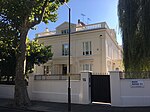Warwick Avenue, London

Warwick Avenue is a residential avenue in the Little Venice area of Maida Vale, London. Its southern end is situated adjacent to Paddington Basin, to the north of Paddington station. The street, originally Green Lane and initially Warwick Road before being renamed Warwick Avenue, was named after Jane Warwick of Warwick Hall, Cumbria, whose father-in-law was John Morehead, who in turn was the son-in-law of Robert Thistlethwaite, who leased the land.At the junction of Warwick Avenue with Warrington Crescent and Clifton Gardens is the Anglican Church of St Saviour, consecrated 1856 but rebuilt in modern style in 1973–76. The church was used for the wedding scenes in the promotional video for The Human League hit Love Action (I Believe in Love). Warwick Avenue tube station, a London Underground station on the Bakerloo line, is located on the street. Warwick Avenue houses one of the remaining thirteen Grade II listed Cabmen's Shelters used by London's taxi drivers as a place to buy food and (non-alcoholic) drink."Warwick Avenue", a 2008 single from the album Rockferry by Duffy, took its name from the location after the singer accidentally alighted at Warwick Avenue tube station when unfamiliar with the London Underground.
Excerpt from the Wikipedia article Warwick Avenue, London (License: CC BY-SA 3.0, Authors, Images).Warwick Avenue, London
Warwick Avenue, London Paddington
Geographical coordinates (GPS) Address Nearby Places Show on map
Geographical coordinates (GPS)
| Latitude | Longitude |
|---|---|
| N 51.522763888889 ° | E -0.18302777777778 ° |
Address
Warwick Avenue 32
W9 2PT London, Paddington
England, United Kingdom
Open on Google Maps










